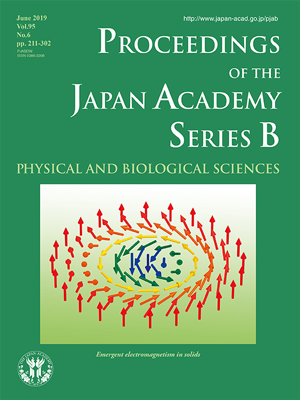About the Cover
Vol. 95 No. 6 (2019)
Electrons in solids behave as microscopic magnets due to their internal degrees of freedom, called spin. These electron spins interact with each other, and in some materials they form a pattern of magnetic structure. Ferromegnets are a representative example where electron spins align parallel, while producing the macroscopic magnetic moments. Another example is antiferromagnets where neighboring spins align anti-parallel, while macroscopically canceling the magnetic moments.
In addition to these examples, recent intensive studies have focused tilted or twisted structures of spins. Dr. Nagaosa (pp. 278-289) has explored the physical consequences of these tilted spin structures theoretically, and predicted many intriguing phenomena realized by coupling between the magnetic moments and the moving electrons in a framework of gauge theory. The essence of his theory is that the quantum mechanical amplitude of an electron acquires a phase factor when hopping between sites with different directions of the magnetic moments, in analogy to that under an external electromagnetic field. Therefore, the tilted magnetic moments induce an effective electromagnetic field, called an “emergent electromagnetic field (EEMF)”.
The skyrmion, as shown in the Figure, offers an ideal playground for EEMF, since it is characterized by the solid angle 4π subtended by the magnetic moments pointing all in different directions. This is a topological particle made from many magnetic moments showing various emergent electromagnetic phenomena.
Dr. Nagaosa also extended the concept of EEMF to a wide range of quantum materials and phenomena; strongly correlated electronic systems, such as high-Tc cuprate superconductors, an anomalous Hall effect in magnets, a spin Hall effect in semiconductors, a ferroelectricity of spin origin, i.e., multiferroics, and photovoltaic effects in insulators. These studies provide a unified viewpoint and predicting power for a wide range of condensed-matter phenomena as well as a perspective for their applications.
Yoshinori Tokura, Doctor of Engineering
Director
RIKEN Center for Emergent Matter Science




